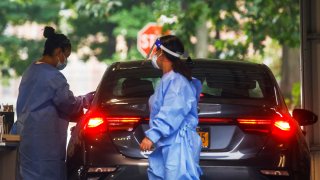
- The rate of new monkeypox cases in the U.S. is slowing, according to CDC Director Dr. Rochelle Walensky.
- There is a decline in the growth of monkeypox across the country and globally, though it is still increasing in certain regions of the U.S.
Monkeypox continues to spread across the U.S., but the pace of new cases has slowed over the last several weeks, Dr. Rochelle Walensky, director of the Centers for Disease Control and Prevention, told lawmakers Wednesday.
While the virus is still spreading at a rapid clip in certain regions of the U.S., the growth of new monkeypox cases across the country and globally has been abating in recent weeks, she testified before the Senate Committee on Health, Education, Labor and Pensions on Wednesday.
Get Boston local news, weather forecasts, lifestyle and entertainment stories to your inbox. Sign up for NBC Boston’s newsletters.
"We approach this news with cautious optimism," she said at a hearing.
The U.S. is working to contain the largest monkeypox outbreak in the world, with more than 22,600 cases across all 50 states, Washington D.C. and Puerto Rico, according to data from the CDC.
The disease is rarely fatal, but causes painful lesions resembling pimples or blisters. There has been one confirmed death in the U.S. as a result of the disease, according to Walensky.
Money Report
The Jynneos vaccine, manufactured by Danish biotech company Bavarian Nordic, is the only approved monkeypox vaccine in the U.S. Two doses are administered 28 days apart, and CDC officials say it's crucial for people at risk to receive the second shot. It takes two weeks after the second dose for the immune system to reach its peak response.
People who have monkeypox should stay at home until the rash has healed and a new layer of skin has formed, keep a safe distance from other people, and refrain from sharing any objects or materials with others, according to CDC guidance.






